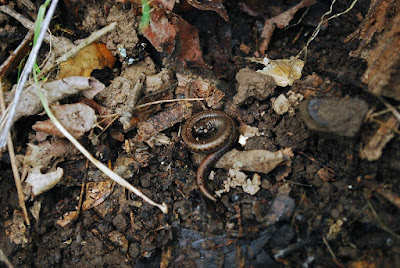A small creature uncovered
In celebration of yet another week of raining, I would like to share how I discovered rock bowling. In the beginning, I wanted to start a vegetable garden but in the country you have to put up a deer fence to garden, and a deer fence requires somewhat level ground which only exists in my backyard under the buildings where plants won't grow, so I need to install a low rock wall to hold the leveled soil, and I don't want to go all suburban by buying fancy manufactured retaining wall blocks, so I have been combing the hills and dales of the Dipper Ranch for suitable garden wall rocks. I am sure others have discovered rock bowling although maybe not by such a circuitous route.
I am trying to collect local rocks off the ranch to match the cemented and moss-covered low wall someone long ago installed along the east side of the garage. As I roam the pastures and hills, I look for rocks big enough to put in a wall but not too heavy to carry up and down hills. This spring, I discovered the hill above the east springbox burps up rocks after rain. This slope is steep and after two trips of carrying armloads of rocks, I started tossing and rolling them down instead. My technique is to toss or roll all nearby rocks towards an intermediate downslope shelf, and then move down the hill and toss/roll those rocks down to the next flat shelf, add more rocks as I go downhill, and so on until the rocks are scattered about the ranch road at the bottom of the slope where I pick them up with a wheel barrow.
To counteract tedium and gravity, I roll the biggest rock down first and then try to hit it with all the subsequent rocks, and thus, it becomes Rock Bowling. Sometimes the rocks explode apart when they hit which weans out the ones too weak for a rock wall anyway. Rock bowling does not require fancy shoes, shirts, balls or beer and is wholesome country entertainment.
With time, my backyard started to fill up with loose piles of rocks near the future garden spot. Then came the spring rains and sun and the rocks got surrounded by tall grass and thistles which was a problem when I went to mow for the Easter picnic, so I decided to consolidate my rock collection onto a nearby concrete pad.
Living and hiding underground and under rocks and logs during their active wet season, exposed slender salamanders will freeze in a coiled position to avoid detection, and then might rapidly uncoil and bounce on the ground to get away. Sticky mucous on the slender salamander's skin can glue a predator's mouth shut (CalHerps).
While moving the rocks to the concrete pad on the first day, I found several California slender salamanders. These are thin, brownish salamanders with tiny legs which live under damp logs, bark, leaf litter and rocks. The ones I see on the Dipper Ranch usually have a broad red-copper band down their back. Because of their slim profile, hidden legs, and their tendency to curl up, many people mistake them for worms, and slender salamanders are often called worm salamanders. They breathe through their moist skin, and the creases which track across their back and down their sides (costal grooves) actually increase the surface area through which they breathe and further make them appear like segmented worms.
Slender salamanders are commonly found in the wet part of spring, so I was not surprised when I found the first two under the twice-moved rocks and I relocated them under the knobby roots of a nearby buckeye tree away from my mowing. On the second day of mowing, I found a huge slender salamander as I was moving rocks once again. This one was 11.3 cm from snout to tip of tail and quite lively, so I decided to put it in a terrarium for a day so I wouldn't accidentally hit it while I finished up my first big spring mowing.
Unfortunately, that night the slender salamander slipped out of the extremely slim slits in the terrarium top and was lost somewhere in the kitchen. My pre-party housecleaning turned into a salamander search. After encountering many a dust ball, I eventually found the long and lanky salamander behind the refrigerator. This time, I placed it inside a tank with a screen lid and hurriedly finished my mowing.
A dust snake found under the refrigerator - eek, keep looking.
Then I deposited the long fellow at the newly designated salamander safety zone under the buckeye tree and I donated a few bowling rocks to create an inviting habitat. I still don't have a vegetable garden, but I do have a salamander sanctuary.
The creature has eyes and tiny limbs.
See also:California slender salamander, Batrachoseps attenuatus
California Herps
Western Reptiles and Amphibians, Third Edition, Robert C. Stebbins.




Handsome handsome! Love the watchful, cautious gaze.
ReplyDeleteI called the salamander in the middle photo "mascara eyes".
ReplyDeleteRock bowling sounds like fun! I love that you are making the effort to use natural stone for your garden wall. What an interesting salamander...I almost never see any salamander species. Love the tiny little arms.
ReplyDeleteHa! Dust snake...who doesn't have one of those? :-)
Thank you for looking out for these little guys. I always scream when I first encounter these guys (thinking they are giant worms), but fear is replaced by adoration as soon as I see those little eyes and legs.
ReplyDelete